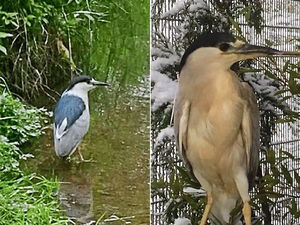Feather in Shropshire's cap as DNA tests show Noddy the heron is a rare visitor indeed
He's a character loved by those who have come across him in Shropshire – and now DNA testing has proved that Noddy the heron is one special bird.

Wildlife experts have carried out tests on the bird, who unexpectedly chose to make Shrewsbury his home.
Noddy was taken in by Shropshire's Cuan Wildlife Rescue in November after living in Shrewsbury's Dingle for about seven months.
People travelled from all over to see the heron, but a member of the public raised concerns about his health as winter fell and fish stocks plummeted.
He's since been recovering at the centre in Much Wenlock where he has put on weight and now staff are deciding his future.
Fran Hill, manager at Cuan Wildlife Rescue, said they'd ordered a DNA test for Noddy to better understand his needs and the results confirmed he is a rare American black-crowned night heron.
Although fairly ubiquitous in some parts of the world, the black-crowned heron is a very unfamiliar sight in the United Kingdom. A pair of adults were seen with two recently fledged juveniles in Somerset in 2017, which is the first proven breeding record of wild black-crowned night herons in the country.





